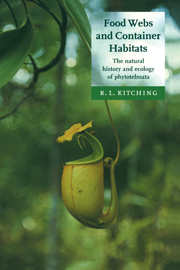Book contents
- Frontmatter
- Contents
- Preface
- 1 Introduction
- Part I The container flora, fauna and environment
- Part II Methods and theories
- Part III Patterns in phytotelm food webs
- 7 Food-web variation across geographical regions
- 8 Food-web variation within a continent: the communities of tree holes from Tasmania to Cape Tribulation
- 9 Food-web variation at smaller spatial scales: regional and local variation in tree-hole and Nepenthes webs
- 10 The role of the host plant
- 11 Variation through time: seasonality, invasion and reassembly, succession
- Part IV Processes structuring food webs
- Part V Synthesis
- Annexe: The phytotelm bestiary
- References
- Index
8 - Food-web variation within a continent: the communities of tree holes from Tasmania to Cape Tribulation
Spatial pattern: intermediate scale
Published online by Cambridge University Press: 26 August 2009
- Frontmatter
- Contents
- Preface
- 1 Introduction
- Part I The container flora, fauna and environment
- Part II Methods and theories
- Part III Patterns in phytotelm food webs
- 7 Food-web variation across geographical regions
- 8 Food-web variation within a continent: the communities of tree holes from Tasmania to Cape Tribulation
- 9 Food-web variation at smaller spatial scales: regional and local variation in tree-hole and Nepenthes webs
- 10 The role of the host plant
- 11 Variation through time: seasonality, invasion and reassembly, succession
- Part IV Processes structuring food webs
- Part V Synthesis
- Annexe: The phytotelm bestiary
- References
- Index
Summary
The eastern seaboard of Australia at the time of the European invasion 200 years ago presented a continuum of forest from southern Tasmania to the tip of Cape York (White 1986). These forests presented then, as they do now, a complex mosaic. Fire-maintained, eucalypt-dominated woodlands and forests, in one form or another, occupied the drier segments of the landscape. In the moister, monsoonal North, in the cool wet uplands and in a series of smaller pockets on the more protected wetter side of hills, in gorges and valleys, highly diverse ‘closed’ forests occurred: the rainforests. Since the European invasion the overall extent of each of these forest types has changed. Vast areas of euclaypt woodland and forest have been cleared for timber and to produce grazing land. The rainforests were an early target, containing as they did valuable ‘cabinet’ timbers – red cedar, hoop pine, satin ash, silky oak – the common names all reflect the high value placed, then and now, on these precious timbers. About half of Australia's rainforests were cleared between 1788 and the present day, but patches remain from Tasmania in the south to the tip of Cape York.
All these rainforests have structural properties in common: they frequently form closed canopies; they are dominated by a mix of evergreen species; they contain a rich flora of epiphytes, vines and lianes; and they contain the continent's richest faunal assemblages.
- Type
- Chapter
- Information
- Food Webs and Container HabitatsThe Natural History and Ecology of Phytotelmata, pp. 176 - 194Publisher: Cambridge University PressPrint publication year: 2000



